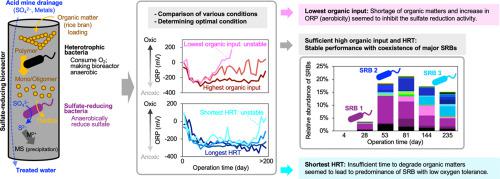Journal of Hazardous Materials ( IF 12.2 ) Pub Date : 2021-09-06 , DOI: 10.1016/j.jhazmat.2021.127089 Yuya Sato 1 , Takaya Hamai 2 , Tomoyuki Hori 1 , Tomo Aoyagi 1 , Tomohiro Inaba 1 , Kentaro Hayashi 3 , Mikio Kobayashi 2 , Takeshi Sakata 3 , Hiroshi Habe 1

|
Typically, sulfate-reducing bioreactors used to treat acid mine drainage (AMD) undergo an initial incubation period of a few weeks to acclimatize sulfate-reducing bacteria (SRB), although necessity of this preincubation has rarely been evaluated. To reduce time and economic cost, we developed an SRB acclimatization method using the continuous flow of AMD into bioreactors fed with rice bran, and compared with the conventional acclimatization method. We found that the SRB sufficiently acclimatized without the preincubation phase. Furthermore, we examined the performance and SRB communities in bioreactors operated for >200 days under seven different conditions, in which the amount of rice bran added and hydraulic retention times (HRTs) were varied. A comparison of the various bioreactor conditions revealed that the lowest rice bran amount (50 g) and the shortest HRT (6 h) caused a deterioration in reactor performance after day 144 and 229, respectively. In both cases, relatively aerobic environments developed due to the lack of organic matter seemed to inhibit sulfate reduction. Of the conditions tested, operation of the bioreactors with 200 g of rice bran and an HRT of 12.5 h was the most effective in treating AMD, showing a sulfate reduction rate of 20.7–77.9% during days 54–242.
Data and materials availability
All data needed to evaluate the conclusions of this study are presented in the paper and/or the appendix.
中文翻译:

基于物理化学和微生物组分析的硫酸盐还原生物反应器有效处理酸性矿山排水的最佳启动条件
通常,用于处理酸性矿山排水 (AMD) 的硫酸盐还原生物反应器经过几周的初始孵育期以适应硫酸盐还原细菌 (SRB),尽管很少评估这种预孵育的必要性。为了减少时间和经济成本,我们开发了一种 SRB 驯化方法,该方法使用 AMD 连续流入以米糠喂养的生物反应器,并与传统的驯化方法进行比较。我们发现 SRB 在没有预孵化阶段的情况下充分适应了环境。此外,我们检查了在七种不同条件下运行超过 200 天的生物反应器的性能和 SRB 群落,其中米糠添加量和水力停留时间 (HRT) 各不相同。各种生物反应器条件的比较表明,最低的米糠量 (50 g) 和最短的 HRT (6 h) 分别导致第 144 天和第 229 天后反应器性能下降。在这两种情况下,由于缺乏有机物而形成的相对需氧的环境似乎抑制了硫酸盐的还原。在测试的条件中,使用 200 克米糠和 12.5 小时 HRT 的生物反应器对治疗 AMD 最有效,在第 54-242 天显示硫酸盐减少率为 20.7-77.9%。
数据和材料可用性
评估本研究结论所需的所有数据均在论文和/或附录中提供。











































 京公网安备 11010802027423号
京公网安备 11010802027423号